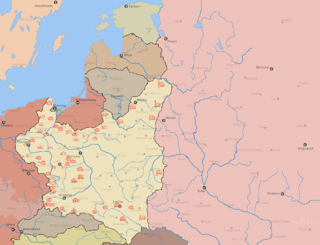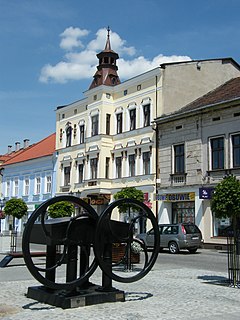
The Battle of Tomaszów Lubelski took place from 18 September to 20 September 1939 near the town of Tomaszów Lubelski. It was the second largest battle of the Invasion of Poland and also the largest tank battle of the campaign. It resulted in the surrender of Army Krakow on 20 Sept. 1939.

The 22nd Mountain Infantry Division was a pre-war unit of the Polish Army. It was one of two mountain infantry divisions of Poland to take part in the Invasion of Poland of 1939. Currently its traditions are continued by the 21st Podhale Rifles Brigade. Until 1939 the unit was commanded by Col. Leopold Engel-Ragis and was stationed in and around the towns of Sanok, Przemyśl and Sambor.

Władysław Bortnowski was a Polish historian, military commander and one of the highest ranking generals of the Polish Army. He is most famous for commanding the Pomorze Army in the Battle of Bzura during the invasion of Poland in 1939. Also notable for serving as president of the Józef Piłsudski Institute of America between 1961 and 1962.
Podhale Rifles is the traditional name of the mountain infantry units of the Polish Army. Formed in 1918 out of volunteers of the region of Podhale, in 1919 the smaller detachments of Podhale Rifles were pressed into two mountain infantry divisions, the 21st Mountain Infantry and 22nd Mountain Infantry Divisions, as well as into three brigades of mountain infantry and were considered elite units of the Polish Army.
Kraków Army was one of the Polish armies which took part in the Polish Defensive War of 1939. It was officially created on March 23, 1939 as the main pivot of Polish defence. It was commanded by Gen. Antoni Szylling. Originally, Kraków Army was to be made of seven infantry divisions, two cavalry brigades and one mountain brigade. On September 1, 1939, General Szyllling had the force which consisted of five infantry divisions, two cavalry brigades and one brigade of mountain infantry. Altogether, the army was made of 59 battalions, 29 squadrons, 352 cannons, 90 tanks, two armoured trains and 44 planes. These forces were not enough to halt German advance, especially in the area north of Częstochowa, where Kraków Army connected with Łódź Army. Main thrust of Wehrmacht panzer units was directed there, and this area was defended only by the Polish 7th I.D., which was destroyed in the early days of September 1939, opening the way towards central Poland.

Mieczysław Ludwik Boruta-Spiechowicz was a Polish military officer, a general of the Polish Army and a notable member of the post-war anti-communist opposition in Poland.

The 21st Mountain Infantry Division was a pre-war unit of the Polish Army. It was one of two mountain infantry divisions of Poland to take part in the Invasion of Poland of 1939. Currently its traditions are continued by Polish 21st Podhale Rifles Brigade. Until 1939 the unit was commanded by Gen.bryg. Józef Kustroń and was stationed in and around the towns of Nowy Sącz, Bielsko, Cieszyn, Bogumin, Kraków.
The Polish 4th Infantry Division was created following Polish independence after the end of World War I. The division participated in the Polish-Ukrainian War in 1919. During World War II, the division existed as three wholly separate organizations, the original incarnation of the division as part of the prewar Polish Army, the second incarnation armed and equipped by the western Allies, and the final incarnation armed and equipped by the Soviet Union. The second and third incarnations of this division existed simultaneously from 1944 until 1947.
Polish 6th Infantry Division was a unit of the Polish Army in the interbellum period, which fought in the Polish–Ukrainian War, Polish–Soviet War and Polish September Campaign. It was formed on May 9, 1919, in the area around Kraków, its first commandant was Colonel Ignacy Pick. Between 1919 and 1920, the unit fought Ukrainian troops in eastern part of former Galicia. Then, it participated in the Polish–Soviet War, halting the advance of Soviet First Mounted Army led by General Semyon Budyonny. Several soldiers were after the conflict awarded with various orders, including the Virtuti Militari. In 1921, when hostilities ended, the Division returned to its bases – headquarters and most regiments were stationed in Kraków, some other regiments were garrisoned in Tarnów and Wadowice.
Jan Jagmin-Sadowski, was a general of the Polish Army, having served in World War I as a member of Józef Piłsudski's legions, as well as commanding Polish forces during the invasion of Poland in 1939.
5th Lwów Infantry Division was a unit of the Polish Army in the interbellum period, with headquarters stationed in Lwów. It was created on May 20, 1919, during the Polish–Ukrainian War in Eastern Galicia. Originally, it consisted of three infantry regiments, but later it was strengthened with additional two. During Polish September Campaign it was commanded by General Juliusz Zulauf. The Division consisted in September 1939 of these regiments:

Jabłonków incident refers to the events of the night of August 25/26, 1939, along the Polish-Slovak border, when a group of German Abwehr agents attacked a rail station in Mosty. The main purpose of the attack was to capture the Jablunkov Pass, with its strategic railroad tunnel, until the arrival of the German armed forces. The attackers were repelled by units of the Polish Army, and the incident is regarded as a prelude to the German invasion of Poland. The Jabłonków Incident has been named the first commando operation of the Second World War.

Jan Wojciech Kiwerski (nom de guerre Oliwa, also Dyrektor, Kalinowski, Lipinski, Rudzki, Ziomek was a colonel of the Polish Army and commandant of the 27th Home Army Infantry Division. Kiwerski was killed in action on April 18, 1944, during Operation Tempest during World War II.
35th Infantry Division was a reserve unit of the Polish Army in the Second Polish Republic. It did not exist in peacetime organization of the army, and was formed between August 31 - September 4, 1939, during the Invasion of Poland.

The Intervention Corps was a tactical unit of the Polish Army in the Second Polish Republic. It did not exist in the peacetime organization of the Polish Army, and was created for specific purposes only. Its task was to intervene in special circumstances, both inside Poland and outside of the country.

Jozef Jaklicz (1894–1974) was a soldier of the Austro-Hungarian Army and the Polish Legions in World War I, and officer of the Polish Army in the Second Polish Republic, nominated to the rank of General brygady. He fought in World War I, Polish–Soviet War, Polish–Ukrainian War and the Invasion of Poland.
Leopold Endel-Ragis (1894–1943) was soldier of the Polish Legions in World War I and the Austro-Hungarian Army, and colonel of infantry of the Polish Army in the Second Polish Republic. He fought in World War I, Polish–Soviet War and the Invasion of Poland, and was a member of the Home Army.

Kazimierz Wincenty Iranek-Osmecki was an infantry colonel (pułkownik) in the Polish Army, and colonel in Poland's Home Army (AK). He fought in the 1944 Warsaw Uprising, and was responsible for negotiations between the Home Army and the German Wehrmacht.

Tadeusz Stefan Aleksander Münnich was a soldier of the Polish Legions in World War I, and Colonel of Infantry of the Polish Army in the Second Polish Republic. Born on August 18, 1893 in Lemberg, Austrian Galicia, he died on October 12, 1959 in London.













